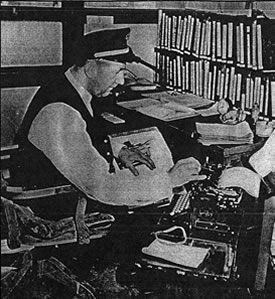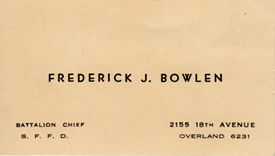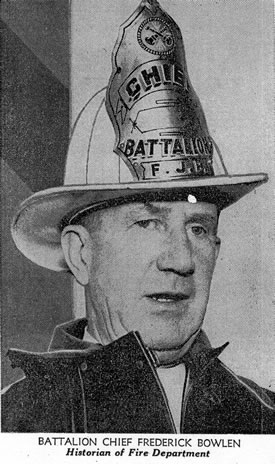
- Guardians Home
- SFFD Home
- Site Map
- Historical Review
- Apparatus
- Chiefs of Department
- Chronology
- Charles H. Ackerson
- Charles J. Brennan
- Keith P. Calden
- Andrew C. Casper
- Emmet C. Condon
- Robert L. Demmons
- John H. Dougherty
- Charles P. Duane
- Joanne M. Hayes-White
- George H. Hossefross
- Francis P. Kelly
- Frederick D. Kohler
- Frederick F. Postel
- Joseph A. Medina
- Thomas R. Murphy
- William F. Murray
- Jeanine Nicholson
- Edward J. Phipps
- David Scannell
- Patrick H. Shaughnessy
- Albert J. Sullivan
- Dennis T. Sullivan
- Paul J. Tabacco
- Mario H. Trevino
- Edward P. Walsh
- Franklin E. R. Whitney
- Companies
- Events
- Past Events
- SFFD 150th Anniversary
- PPIE 100th Anniversary
- 1906 Expo
- 1989 Quake Party - 2009
- 65' Ladder Presentations
- Broderick & Terry Duel
- Coit Tower 75th Anniversary
- Cole Valley Fair
- Gold Hydrant - April 18th
- Jimmy's Car Show
- Lower Haight Street Fair
- Lotta's Fountain - April 18th
- Musters
- Presidio Car Show
- Station 28 75th Anniversary
- Fireboats
- Firehorses
- Firehouses
- Fires
- In The Line Of Duty
- Museum Collections
- Musters
- Notable People
- Organizations
- Gift Shop
- Volunteers
- Related Links
- Contact Us
- Research Requests
- Photo Gallery
- Videos
- Donations
| Notable People:
Frederick J. Bowlen
Battalion Chief, San Francisco Fire Department
Chief Bowlen followed the footsteps of his father, Thomas, who was a member of Hose Co. No. 3, 1880 HOW BATTALION CHIEF BOWLEN STARTED AN INTEREST IN THE HISTORY OF THE S.F.F.D. Three Decades of Smoke and Flames: When on July 2, 1929, Mill Valley in Marin County went afire, Battalion Chief Frederick J. Bowlen was chosen by Acting Chief Engineer Charles J. Brennan to answer that city's call for aid. Four powerful pumping engines and hose wagons, together with a chemical fire engine and a crew of 50 officers and men were on their way within 12 minutes after the call reached San Francisco. Fire companies from neighboring towns were also on the scene. On the hills where the greatest volume of fire was centered a 25-mile an hour wind was blowing. It was a fight against every vicious agency of nature. In the first place the humidity was so low that buildings were bursting into flame long before the oncoming sweep of fire reached them. On the scene, soldiers from the Presidio and Fort Baker, a crew from a Coast, Guard cutter, 25 San Francisco policemen and thousands of civilians were valiantly attempting to help. Chief Bowlen made a rapid survey of the fire and started out at once to save the business district. Powerful streams were played on house tops, on nearby trees, and in other places high into the air. It was the making of an artificial rain that helped to raise the humidity to a point above which spontaneous ignition was liable to occur. These streams were kept wide open for hours as there was a plentiful water supply in the downtown area. Meanwhile, several companies were fighting in the upper area, and the fight was won. Chief Bowlen generously admits the danger point was overcome by a change of wind about 9 o'clock that night. Fight Another Proof of Unsurpassed Efficiency: The fight had been handled in a remarkable manner — one more, record to be placed beside thousands of others in the history of the officers and men of the most efficient fire department in the world. (This rating of the SFFD is attested to by visiting fire officials from all over the world after inspections here.) After the embers had cooled, a meeting was held in Mill Valley and Chief Bowlen called across to give suggestions for future safeguards. As he was leaving the hall, he was approached by a visitor from New York, who said she had a 12-year-old son. Would the chief some time tell the lad about firefighting in general? Bowlen said he would sit down and write a few stories for the boy. He did. But young Laurence M. Symmes Jr. of New York requested more by mail. These were supplied, but more were demanded. So Chief Bowlen found himself digging into the history of the department to supply the curiosity of a small boy. From such a small incident has come the first accurate and complete history of the San Francisco Fire Department. In his office in the firehouse on Eighteenth Avenue the chief now has a cabinet filled with 63 volumes that contain 22,000 typewritten pages. A rough estimate places this remarkable history at 6,600,000 words. Only Reward Leaving Record to Posterity: A labor of love, Chief Bowlen calls it. And that is what it is. He expects to make nothing from it; he only desires that before he goes he will have left behind the true record of the service he has loved and of the work that has given him great happiness. The man whose tireless effort brought into existence this history that The Chronicle will publish is well capable in every way for its telling. He was born and reared in San Francisco, coming from a pioneer family. His father was a fireman and later a police officer. In 1903, Frederick J. Bowlen joined the department as a member of Truck Company No. 4. He experienced the trying days of the great fire of April, 1906. Now he ranks as senior Battalion Chief in the department. (1939) Knowing that man is, of course not immortal, the Chief has made arrangements that his work be carried on after his retirement By legal means he has decreed that the volumes will go into the hands of Louis W. Hage, a fireman attached to his division, who is already well into the work. Young Hage, only six years in the department, has already done a great amount of research and was chosen to "carry on" because of his keen interest. Painstaking Search For Data Unending: Ten years of so many allotted hours a day, vacation visits to the Huntington Library and San Marino, the State Library at Sacramento, the Jenny Weir collection of historical matter at Reno, trips into the Mother Lode country where still many of our pioneer societies are. These are only part of Bowlen's search for the facts. Every record of the fire department went into smoke and ash in the great fire of 1906. That meant a start under the greatest difficulty for every scrap of information. And yet today, Chief Bowlen has several hundred pictures, most of which no one thought were in existence. He has a complete roster of the members of the department from 1849. These include the Volunteers, the Exempts and the Paid departments. The name and history of practically every man who ever signed the fire rolls; stories of the heroes; lives of every chief, fire marshal are in the volumes. And bound there in the cabinet for posterity are compilations of causes of fires, the history and romance of early day fire bells, detailed accounts of firemen injured or killed, social affairs, parades, records of the pioneer engines and what happened to them, the origin of our water supply, a long record of every notable fire since 1847, (alarms since 1775), even stories of each firehorse—and countless other data unbelievable in scope. From this mass of material, Battalion Chief Frederick J. Bowlen has now got down to concrete effort—writing of the History of the San Francisco Fire Department. From these volumes he is taking the essential facts, the tales of heroism, the valuable reports, the details of history that will make one complete, honest, accurate account. Battalion Chief Frederick J. Bowlen was yesterday (1939) notified that he had been made an honorary member of the famous pioneer Liberty Engine Company No. 1, Gold Hill, Nevada. Notification came on an original highly-colored lithographic certificate, dated May 22, 1867. Gold Hill, once a teeming mining city, is now practically a ghost city, but its Fire Department is maintained with all the ancient traditions. |




